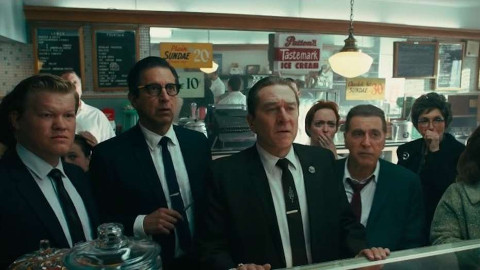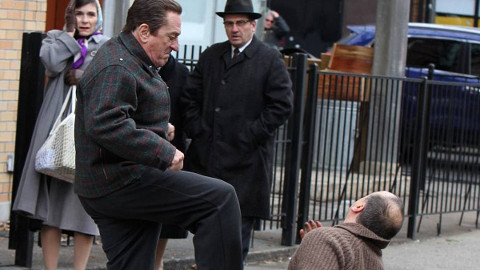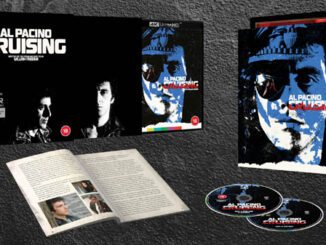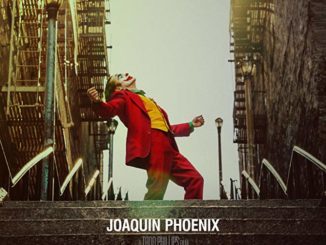The Irishman (2019)
Directed by: Martin Scorsese
Written by: Charles Brandt, Steven Zaillian
Starring: Al Pacino, Bobby Cannavale, Joe Pesci, Robert De Niro
USA
AVAILABLE ON NETFLIX
RUNNING TIME: 209 mins
REVIEWED BY: Dr Lenera

Sitting in a nursing home, the aging Frank Sheeran, a World War II veteran, recounts his time as a mafia hitman. In 1950s Pennsylvania, Sheeran drives meat packing delivery trucks and starts to sell some of the contents of his shipments to a local gangster. After getting accused by his company of theft, lawyer Bill Bufalino gets him off, then introduces Sheeran to his cousin Russell, the head of the northeast Pennsylvania crime family. Sheeran begins to do jobs for Russell, including murders, and eventually meets powerful but crooked labour union Jimmy Hoffa. Sheeran becomes Hoffa’s main bodyguard while he is on the road, but then John F. Kennedy is elected president and his brother Robert sets out to bring down Hoffa….

Martin Scorsese has been in the news quite a bit lately, though not entirely for his latest movie. Much of it is because of his comment about Marvel movies not being cinema, which was soon followed by Francis Ford Coppola, Ken Loach and Pedro Almodovar or also chipping in to slag off the all-powerful superhero genre. I’ve said it before and I’ll say it again, it’s the almost total dominance of these films – and I’ll extend that to that nefarious company Disney – in cinemas that I really dislike rather than the films themselves, something Marty mentioned in a follow-up article where he also explained what he initially meant with great clarity. Things are so bad that he couldn’t even get any studio to fund The Irishman, a project he’s been wanting to do since 2007, until Netflix stepped in with their bottomless pit of money. This has also brought its problems, in particular the limited theatrical exhibition window which has caused some cinema chains to refuse to show the film in protest, something Netflix are no doubt really happy about. I had to travel a fair bit to see The Irishman, and when I learned that the three hour and a half movie didn’t even have an interval I couldn’t help but feel nostalgic for the days when longer films did tend to be split up and I didn’t have to spend the last half hour desperate to relieve myself. I decided not to take a drink into the auditorium at all. Thankfully the film itself did hold the attention, though I don’t think it’s quite the masterpiece that some critics are apparently claiming. Then again, while I do like admire much of Scorsese’s stuff and love some of it, I’m that rare moviegoer who doesn’t consider his gangster epics to be his best work, despite the many pleasures that they undoubtedly offer and the skill with which they are crafted.
The Irishman lets you know exactly what is is in its opening shot. One of Scorsese’s canonical moments is the two-and-a-half-minute sequence in Goodfellas where, in a single, unbroken take, the camera, gliding and swiveling to absorb every detail along the way, follows Henry Hill and his girlfriend Karen from Henry’s car, through the kitchen of the Copacabana Club and into the hurly-burly of the nightclub, accompanied by the sound of the Crystals singing ‘Then He Kissed Me’. It really indicates the glamour of the life that Hill has chosen. Things are good – at least at the moment. The Irishman begins in a similar vein. As The Five Satins’ ‘In the Still of the Night’ plays, we get another lengthy tracking shot. However, this time it’s through a nursing home, eventually finding and focusing on a very aged man virtually at death’s door who begins to tell his story to no one in particular. This immediately tells the viewer that this film is certainly going to have a lot of similarities with what we’ve seen before, and soon we are indeed seduced by the almost cosy [despite the violence that we see] familiarity of narration, ‘whacks’, amusing conversations, needle drops on the soundtrack and the almost anthropological lens through which Scorsese views his mobsters. But we’re not quite back there, because the 76-year old film-maker has ensured that this particular effort, hopefully not his last feature film but probably his last crime movie and his last to feature Robert De Niro, Joe Pesci and several other familiar gangster faces, looks at its subject through the act of getting near to death – and having a legacy of brutality to deal with. I’m not going to make a claim for Sheeran being a substitute for Scorsese himself because I doubt that Scorsese regrets making almost any of his movies, though it’s possible that he considers his reputation for violence to have overshadowed the many other things that he’s done. But it does mean that the final section of the film is really rather depressing and probably uncomfortably near the knuckle if you’re of an advanced age yourself, even if hopefully you don’t have loads of terrible sins weighing on you.
Frank’s narration immediately takes us back to a car trip Frank and Russell and their respective wives Irene and Carrie are taking from Philadelphia to Detroit, ostensibly for a wedding. The women like to smoke, and Russell won’t tolerate smoking in what is his car, so they keep having to stop the car so the gals can have fag breaks. I’m surprised that more critics [or maybe they are, I only skimmed two reviews a week of so ago when I wasn’t sure if I was going to see the film] aren’t complaining that the female characters are sidelined. Stephanie Kurtzuba [Irene] and Kathrine Narducci [Carrie], plus Anna Paquin in particular out of the cast members playing his four daughters, are fine enough actresses to show a fair bit of characterisation without being given much to say or do, and I’m not normally the kind of critic to whinge about this kind of thing, but it is undoubtedly disappointing seeing as female characters played by the likes of Lorraine Bracco and Sharon Stone made such an impact in previous Scorsese mob pictures. Anyway, we soon jump back again to Frank and Russell’s first meeting, after which most of the story is told chronologically with a few jump backs to that car journey [which soon has the car break down] and that nursing home – oh, and a brief flashback to Sheeran’s stint in World War II, where we see him gun down two Germans after he’s made them dig their own graves. The time jumping is easy to follow due to subtly different colour schemes, much like Sergio Leone did in his similarly structured [and long] gangster epic Once Upon A Time In America. Sheeran begins to rise and get more and more involved with organised crime. Eventually this leads him to Jimmy Hoffa. Hoffa was a real person, head of the powerful union the International Brotherhood of Teamsters, and somebody who disappeared in 1975, a mystery that still hasn’t been solved. In fact Sheeran was also a real person, the film being based on his memoirs, though he probably exaggerated quite a bit. Still, the explanation he offers for Hoffa’s death is very plausible.

For at least an hour or so, it’s all very fast paced, though when Sheeran begins to get mixed up with Hoffa things, Hoffa even succeeding in befriending Sheeran’s youngest daughter which Russell had unsuccessfully attempted to do, things wind down a bit even though Robert F. Kennedy, who becomes the Attorney General, forms a “Get Hoffa” squad in an effort to bring down Hoffa, who is indeed eventually arrested. In his book, Sheeran claims that he was involved in, though he didn’t pull the trigger[s], JFK’s death, and I’m really surprised that the film doesn’t cover this. Instead, its material feels rather stretched in its middle section, with certainly too many courtroom scenes, but things pick up again when Hoffa is released from prison and increasing complications result in Sheeran having to commit a murder he most definitely doesn’t want to commit. De Niro, in a mostly quiet performance, is especially good here, you really feel Sheeran’s pain while the character is kept slightly opaque like many other De Niro characters, it’s what he does time and time again. Pesci also keeps it low throughout, showing what a fine and subtle actor he can really be, leaving Pacino to do his familiar shouty schtick with unusual word emphases to good effect – and isn’t it great to see De Niro and Pacino not just onscreen together again but sharing scene after scene? The CG to de-age these three works for the most part. It’s most extensive on De Niro seeing as his character is younger than the others and has the most screen time, and there are a few moments when he looks rather waxy in dark lighting, while they’ve also changed the colour of his eyes to a bright blue which looks a little off at times. But otherwise it’s really pretty good. Unfortunately, all this digital wizardry can’t hide the fact that De Niro’s facial expressions are those of an old man, so it’s still kind of strange watching him for much of the time.
There are several impressive set pieces, from a barbershop slaying where Rodrigo Prieto’s camera glides past a florist’s window while we hear the mayhem off-screen, to a somewhat funny sequence in which Frank demonstrates how to choose the right gun for a public slaying and ponders upon whether or not to go to the bathroom before committing the murder. Humour is certainly often present, be it silly conversations about anything from a fish stinking out a car to Hoffa’s obsession with punctuality, to a river area having had so many guns thrown into it after killings that its bed could be filled with the things. I’ll always remember the line, “three people can only keep a secret if two of them are dead”. But the spectre of death hovers more greatly over this film than in any other Scorsese – when new characters are introduced, we even get an on-screen graphic telling us when and how they will die – and eventually turns it into a very mournful reflection on friendship [the sight of Sheeran, Buffalino and several other extremely aged hoods in prison together is sad yet oddly kind of sweet], betrayal and the guilt people take to their graves. This probably makes The Irishman sound even more like the afore-mentioned Leone film, but Scorsese’s is far more realistic in approach and totally lacking in sentimentality. The unflinching look at old age, a subject still not dealt with much in commercial cinema, and the very stately pace of this final section will try a lot of viewers, and I could tell that not everybody in the packed auditorium I saw the film in was comfortable. But one has to admire Scorsese for dealing with this head-on, and I can’t imagine any viewer being left with the impression that crime has been glamourised, something that many have accused Scorsese of doing in the past. This guy, alone because everyone else is either dead or has abandoned him [despite what I said earlier about female roles, Anna Paquin’s final scene is quietly devastating], is totally haunted by all that he’s done, even if he can’t even bring himself to express remorse to a priest.
Otherwise The Irishman isn’t really saying much that’s enlightening, though I guess political and big business corruption is probably a subject we could always do with being reminded of, and we seem to be told that the old days where mobsters paraded about in cool suits and everyone knew [and therefore in many cases respected[ them are gone. And then we get odd things like the sight of lots of taxis identical to the one that De Niro drove in Taxi Driver being pushed into the river, and a few shots of that nightclub, but there’s surprisingly little self-referencing here. While Scorsese does fall back on many of his tropes such as extreme slow motion, and Thelma Schoonmaker’s editing is as punchy as ever when required, his direction is a little more muted than when previously in this world. The soundtrack features less tracks than usual, instead choosing to repeating some of the ones it has two or more times. Familiar Scorsese musical collaborator Robbie Robertson provides a propulsive main theme with a great harmonica beginning, while some other tracks were in previous films. It was weird for me hearing ‘El Negro Zumbon’, a song originating in the 1951 film Anna but heard twice in different versions in the director’s cut of my favourite film of all time, employed as source music, and having the seductive theme from 1948’s The Barefoot Contessa accompany scenes of murder build-up shouldn’t work, but the latter actually does as effective counterpoint. While its extreme length isn’t really necessary and even hampered portions around the middle, while there’s also an undeniable coldness to the proceedings too'[though this is typical of most, though not all, Scorsese], The Irishman shows a Scorsese finally feeling able to make one of the most purely honest of gangster films. We all die, but that way of life cannot help but lead to a slow death inside as well as out. Being whacked is probably a better option.








Be the first to comment